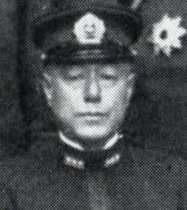Hisanori Fujita
Hisanori Fujita (藤田 尚徳, Fujita Hisanori, October 30, 1880 – July 23, 1970) was an admiral in the Imperial Japanese Navy. After retiring from active service, he served as the Chief Chamberlain of Japan and adviser to the Emperor of Japan during World War II.
Hisanori Fujita | |
|---|---|
 Admiral Hisanori Fujita | |
| Native name | 藤田 尚徳 |
| Born | October 30, 1880 Aichi Prefecture, Japan |
| Died | July 23, 1970 (aged 89) Anjō, Aichi, Japan |
| Allegiance | |
| Service/ | |
| Years of service | 1901–1945 |
| Rank | |
| Commands held | Suma, Kirishima |
| Battles/wars | World War I World War II |
Biography
Fujita was born in Aichi Prefecture, where his father (a former samurai from Tsugaru Domain) served as a school principal. He attended the 29th class of the Imperial Japanese Naval Academy in 1901, graduating 15th of 115 cadets. One of his classmates was the future Prime Minister of Japan Mitsumasa Yonai.
Fujita graduated from the Naval Staff College in 1908, and in December 1911 was assigned to serve on the battleship Shikishima.
In February 1915, during World War I, Fujita was sent as a naval attaché to England, and was promoted to commander while still assigned to the Japanese embassy in London in 1916. After his return to Japan in October 1917, he became executive officer on the battleship Settsu for a one-month period in December 1917. Subsequently he held a number of shore assignments to the end of 1920.
Fujita attained the rank of captain in December 1920, and received his first command, that of the protected cruiser Suma. After a number of shore assignments from 1921 to 1924, he was appointed captain of the battleship Kirishima on December 1, 1924.
He was promoted to rear admiral in December 1925 and became Director of the Personnel Department of the Navy Ministry in December 1926. In November 1929, he attained the rank of vice admiral, and took command of the Yokosuka Naval Arsenal. In June 1930, he was Director of Naval Shipbuilding Command. Fujita became Navy Vice-Minister in June 1932, and Commander in Chief of Kure Naval District in May 1934. In April 1936, he was made a full admiral. He became a naval councilor in December 1936.
Fujita was considered for the post of Minister of the Navy in 1939, but after deliberation and consultation with Admiral Sankichi Takahashi, he stepped aside in favor of Mitsumasa Yonai and went into the reserves in April 1939. After his retirement, Fujita served as Chief Priest of Meiji Shrine until the end of August 1944. He was then appointed Grand Chamberlain to Emperor Hirohito from August 29, 1944 to May 3, 1946, accompanying the emperor to his meetings with head of the American occupation forces, General Douglas MacArthur. However, due to Fujita’s military background, MacArthur ordered his dismissal in 1946.[1]
Fujita died in Anjō, Aichi on July 23, 1970.
Naval Career
From the corresponding article in the Japanese Wikipedia
- Graduated as a Midshipman (14 December 1901)
- Ensign (23 January 1903)
- Sub-Lieutenant (13 July 1904)
- Lieutenant (5 August 1905)
- Lieutenant-Commander (1 December 1911)
- Commander (1 December 1916)
- Captain (1 December 1920)
- Rear-Admiral (1 December 1925)
- Vice-Admiral (30 November 1929)
- Admiral (1 April 1936)
- Retired and went into the reserves (5 April 1939)
Footnotes
- “More Officers Resigning in Japan,” New York Times (1946-01-18).
External links
- Nishida, Hiroshi. "People of the IJN". Imperial Japanese Navy. Archived from the original on 2012-05-09. Retrieved 2014-08-09.